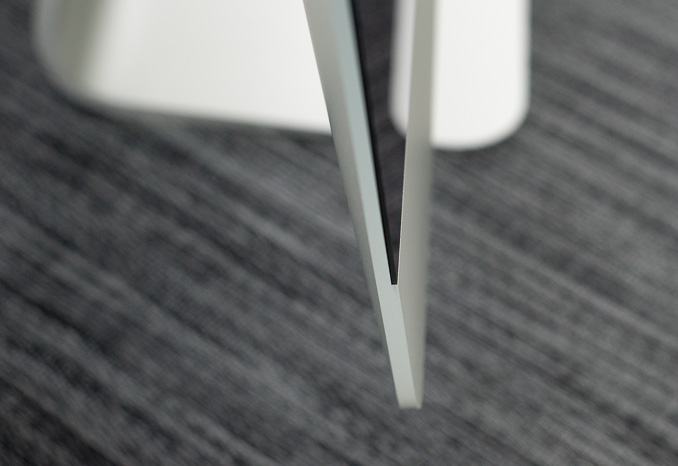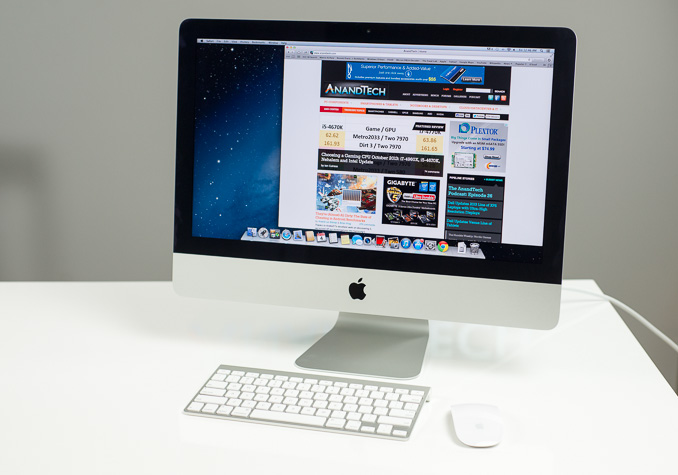21.5-inch iMac (Late 2013) Review: Iris Pro Driving an Accurate Display
by Anand Lal Shimpi on October 7, 2013 3:28 AM ESTFinal Words
Apple continues to have the strongest Mac lineup of its history. While I’m expecting something pretty cool with Broadwell next year, Apple’s Haswell Mac lineup continues to be an evolutionary improvement over the systems that were introduced last year.
The iMac’s industrial design is beautiful. I’m not sure I’m happy with the bezel thickness around the display, but otherwise I’m happy with the way Apple’s 2012 redesign turned out. Particularly with the 21.5-inch model, the compactness of the new iMac is pretty awesome. It’s a lot like the benefits of having a lightweight LCD TV - you only appreciate it when you have to move the thing, but it’s nice to have regardless of how rarely you move it.
Although I didn’t talk about this in the review, the in box wireless peripherals both work well. Combined with the fact that you can get 500Mbps file transfers over 802.11ac (over short distances, with Mavericks), you can really use the iMac with only a single cable and be pretty happy. Toss in Apple’s new 802.11ac Airport Extreme and you’ll have great wireless range as well.
The iMac’s out of box display experience is nothing short of incredible. Imaging professionals in dire need of color accuracy can walk into an Apple store, walk out with the entry-level iMac and have a remarkable experience. I’d love to see a higher resolution panel, but 4K panel pricing isn’t quite low enough yet (not to mention the possibility of Apple wanting to go 5K on its 27-inch display).
I wouldn’t touch either of the iMacs in their default configuration. Thankfully the upgrade to Fusion Drive or an SSD starts at $200, and is a must have. Fusion Drive remains the only solid state hybrid solution I’d touch. If you need a single volume, it’s absolutely the way to go.
CPU performance of the entry-level iMac really is very good. Power users can stand to go for one of the higher-end configurations, particularly if you’re running heavily threaded workloads. Lighter users should enjoy really good single threaded performance out of the base configuration however.
The entry-level iMac offers better integrated graphics performance than we’ve ever seen before, but true gamers will want to spring for a discrete GPU. Iris Pro under OS X (non-gaming) works well and I couldn’t really tell that I wasn’t using discrete graphics.
Thermals aren’t a concern with the base 21.5-inch iMac. The Core i5-4570R had no issues turbo-ing up to 3.0/3.1GHz on a regular basis, and the system fan never ramped up beyond 1400RPM during my testing. Overall the new 21.5-inch iMac is a very compact, cool and quiet machine. The 21.5-inch model in particular is an easy recommendation for anyone looking to get into a Mac desktop. Just make sure to order it with a Fusion Drive or SSD.












127 Comments
View All Comments
mschira - Tuesday, October 8, 2013 - link
Could one buy a super fast USB3 SSD and build ones' own fusion drive on the cheap?Cheers
M.
name99 - Wednesday, October 9, 2013 - link
Yes --- if you're willing to be daring.Essentially you'd need to boot off a third drive (or the network) then use diskutil cs commands to create an LVG then an LV tying the two drives together. There are instructions on the web giving details.
On a different point, I don't think Anand is correct in saying that Fusion works better than other hybrid solutions because it tracks blocks. I think the real answer is that it does a MUCH smarter job of tracking file "temperature". OSX has, since about 10.3, tracked file temperature (which is essentially a combination of how large the file is and how often it's accessed). This was done back then (and is still done) to move the hottest files to a small "hot files" area at the start of a disk for the obvious performance reasons.
Details here:
http://osxbook.com/book/bonus/misc/optimizations/#...
My guess is that Fusion essentially hooks into this mechanism, and just redefines the constants controlling how large the hot file area is to have it cover all of the SSD (minus of course the area for file system metadata, the area that is reserved for fast writes, and so on).
I can't think of any realistic situation (within pure OSX) where tracking by blocks rather than files is useful, and it would require a whole new way of looking at the problem. I think the obvious way to test this would be to look at the behavior of VM images which, assume, as a whole don't count as hot because they are very large, but which do have hot blocks inside them. If you look at IO when, say, starting up a VM, do you see all the IO coming from the HD, or do you see it all come from the SSD, with HD accesses coming later once the VM is booted and we're now pulling in less frequently accessed blocks?
Risas - Thursday, October 10, 2013 - link
What a silly review and comparison. Apple vs Apple, conclusión: the Moore's law still works.CPU performance: It look like Apple made any work instead of changing the Intel CPU, Apple CPU performance comparison? there's no other comparison of the Intel's CPUs? Just look at them, what to spect?
And over and over... Apple iMAc vs Apple iMacs, who wins? Apple, of course.
Final words..."Apple continues to have the strongest Mac lineup of its history" Does any other have MAC lineups? Of course no, as it's a monopolistic stuff. So It's unnecesary to say what's obvious.
Apple's Haswell?? yo write the article as if Apple did anything on the Haswell desing or manufacture.... Maybe Intel have to say something about it...
And here is what really matters: The iMac’s industrial design is beautiful.
No complains about the small breaking-wrist keyboard or any thing as Apple fights againts Apple it wold be always a winner: Apple.
Commodus - Thursday, October 17, 2013 - link
I'd say the Apple vs. Apple comparisons are valid because of the limited all-in-one market. It's hard to find something comparable; a lot of iMac alternatives are either budget models or use significantly different components (see the ASUS Transformer AIO or Lenovo IdeaCentre A730 as examples). The company practically dominates the category, at least in North America and Europe.Haplodepatrijn - Thursday, October 10, 2013 - link
Doses this mean we can finally use the GPU render in Blender ?shweetuant - Friday, October 25, 2013 - link
HiIf I am planning to install Windows 7 64-bit as virtual running side by side with OS X. Is the default 8GB of ram sufficient?
kkirk - Tuesday, December 3, 2013 - link
I was wondering if there will be a late 2013 Macbook Pro 15" review coming soon?